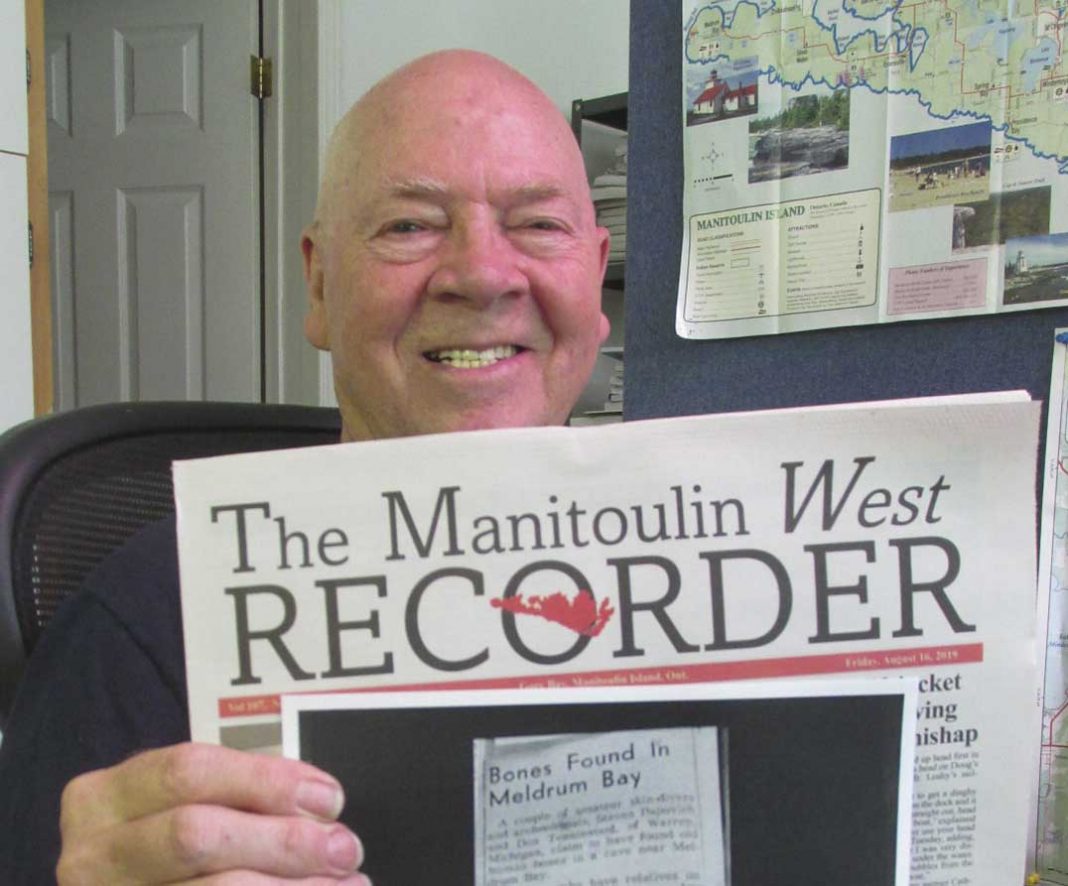MELDRUM BAY – Could the human bones that Don Tenniswood has kept in a box in a closet at home in St. Clair Shores, Michigan—bones that he found in a cave at the Mississagi Straits, near the lighthouse—be connected to the ship the Le Griffon, which sank in 1679?
“It was in August 1963,” Mr. Tenniswood began. “I went with two other people; I wanted to show them the ‘G’ near the Mississagi Lighthouse, where the cave was, and where skeletons had reportedly been moved around. It was on a shallow limestone ledge where we found what we thought was two upper arm bones,” said Mr. Tenniswood, who along with his wife Venus own a camp on the west end of Manitoulin.
Mr. Tenniswood explained, “I took the human bones to my Doctor Norton and asked him what they were. He said they were both part of the upper arm and were a matching set belonging to a small man or woman.” With this in hand he took a light box that had held his eight-millimeter camera and put the two bones side by each, about 18 inches apart, with Styrofoam on the bottom and top, and the box and the bones have remained in his closet at home ever since. “They have never been out of the box. I didn’t know what to do with them.”
“Today with advances such as carbon dating and DNA testing, scientists would be able to determine how old the bones are and the nationality (of the person they belong to),” said Mr. Tenniswood. “The skeletons found in cave could possibly be from someone on tthe he Griffon over 300 years ago. If they are human bones over 300 years ago, and were those of a French person, it could be tied to the Griffon and would have been part of the original six skeletons that were found in the cave.”
Mr. Tenniswood noted he saw ‘The Wreck of the Griffon’ book by Cris Kohl and Joan Forsberg, which she and her husband agree is an excellent book. “When we heard they were going to be making a presentation at History Day in Kagawong on their book, we decided we needed to introduce ourselves. Windsor, Ontario, where they live, is only 15 minutes away from where we live in Michigan. We knew we needed to talk to them.”
“My wife Venus and I went to the presentation in Kagawong by Ms. Forsberg and Mr. Kohl and told our story of finding the bones, and he was very interested,” said Mr. Tenniswood. “I told him that we don’t have the resources to do the testing that would be needed to come to some type of conclusion on the bones; but he said he could do this for me, on a loan basis. So I gave him my contact information. We are here for the summer, but when we get back home I’ll present one of the found bones to him on a loan basis to get the testing done.”
An article in the Manitoulin Recorder, dated August 1963 with the headline ‘Bones Found in Meldrum Bay’ reported in part, “a couple of amateur skin-divers, Steven Papovich and Don Tenniswood, of Warren, Michigan claim to have found old human bones in a cave near Meldrum Bay.”
“The two, who have relatives on the Island, are spending a few week’s vacation here and were originally planning to search for some proof of the sunken Griffon off Meldrum Bay,” the story said. “When they found the water too deep to skin-dive, they started to search the shores for archaeological signs. Mr. Tenniswood came upon a cave, located between the two ‘G’ rocks near the Mississagi Lighthouse, which apparently had not been discovered before. The cave obviously was a bear den,’ when he climbed into the cave. He found a pair of large bones, looking quite old. According to the judgement of hunters, they don’t look like deer bones and no other animal would have bones that size.”
“The find will be checked by professional archaeologists. Maybe the bones come from the crew of the Griffon: that sank near there some 300 years ago?” the article said.
Mr. Tenniswood told the Recorder he was born in Mindemoya and raised in Silver Water. “I went to school in Silver Water until the fourth grade. We returned every year and I still have many relatives in Silver Water,” he said, noting, “my grandfather Arthur was the third or fourth white man to settle in Silver Water. My great grandfather (John Edmonds) landed at Sheshegwaning in a sailboat, with a horse, cow, pigs and blacksmith shop. My uncle Wilbert and my grandfather built a log cabin on the Tecumseh trail. Jack Whyte did a painting of the cabin on the trail and Virginia Matheson has the painting.” He explained the family eventually built a double farm house.
“So, we are a pioneer family,” said Mr. Tenniswood, pointing out his parents got married and had five children. “When I was very young I would go up to the Mississagi Lighthouse to look around and my father worked at Burnt Island, on fishing boats and timbering. He was also the assistant lighthouse keeper at the Duck Islands,” said Mr. Tenniswood. “My mother told me a story she heard when she was growing up about the light keeper having a skeleton holding the lighthouse door open. But he got drunk one night and kicked the skeleton and landed in the water and disappeared. She also told the famous story of six skeletons found by the lighthouse keeper found in a shallow cave at the Mississagi shoreline, with coins and brass buttons about. She always said that someone in the area probably has all those brass buttons and coins in a coffee can. All of this is documented in the Gore Bay museum.”
“If the DNA and carbon dating prove that the bone is 300 years old and belonged to a person of French descent then we might have something here,” stated Mr. Tenniswood. He was 24 years old when the bones were found in August 27, 1963.
“And they have been in a box in my closet the whole time since,” stated Mr. Tenniswood.




